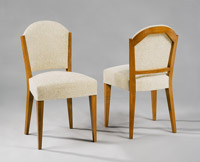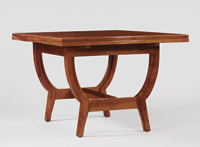1879
|
|
Eugène Michel Printz was born on 2nd June at No. 3 rue des Immeubles Industriels in Paris. It is the
birth year of Jacques-Emile Ruhlmann and Paul Poiret.
Printz receives no specific vocational training; he learns how to be a joiner in his father’s workshop
which produces historising furniture. |
| |
|
|
1905 |
|
Marriage to Suzanne Reding.
Opening of his own workshop L’Atelier 12 rue Saint Bernard. |
| |
|
|
1919 |
|
Beginning of collaberation with Pierre Chareau which benefited both artists. L’Atelier is responsible
for the production of most of the Chareaus furniture up until 1925. |
| |
|
|
1926
|
|
 Eugène Printz exhibits for the first time a bedroom suite in rosewood at the Salon des Artistes
décorateurs in his own name. From now on he only designs contemporary pieces of furniture
although his use of rosewood is still a testimony to his former work as a craftsman.
The carpets are by Voguet, vases and objects by Jean Dunand, early signs of a long and
successful collaboration. Eugène Printz exhibits for the first time a bedroom suite in rosewood at the Salon des Artistes
décorateurs in his own name. From now on he only designs contemporary pieces of furniture
although his use of rosewood is still a testimony to his former work as a craftsman.
The carpets are by Voguet, vases and objects by Jean Dunand, early signs of a long and
successful collaboration. |
| |
|
|
| 1927 |
|
Printz exhibits a bedroom suite in rosewood at the Salon des Artistes Décorateurs.
There, a small table consisting of five elements can be seen for the first time one of his
best-known and most successful designs.
In L'art vivant Ernest Tisserand calls this bedroom "the work of a poet."
At the Salon des Artistes Décorateurs Printz exhibits a sideboard in rosewood with decorated
metal doors by Dunand which fold to each side inside/along a profile. |
| |
|
|
| 1928 |
|
Opening of the Galerie Printz at 81 rue de Miromesnil.
At this time Printz has over 21 employees in his workshop.
Eugène Printz designs a library and salon for the silk manufacturer Debiesse which is exhibited at
the Salon des Artistes décorateurs. There for the first time Printz' own carpet designs can be seen,
which were made by the Pinton workshop in Aubusson.
Printz receives an award for his indirect lighting from the Société pour l'Encouragement.
At the Salon d’Automne Eugène Printz presents amongst other things adjustable picture frames
made of decorated metal which make it easier to secure the canvas. |
| |
|
|
| 1929 |
|
Printz designs a dining room suite in palm wood and decorated metal for Princess de Wagram,
which he exhibits at the Salon des Artistes décorateurs.
He contributes to the design and stage set for the drama Jean de la lune in the Comédie des
Champs-Elysées.
Textiles of his own design which can be used for furniture, walls or curtains can be seen
at the Salon d’Automne. Ernest Tisserand in L’Art vivant describes them as the best at
the fair. |
| |
|
|
| 1930 |
|
Eugène Printz designs a complete apartment for Princess de la Tour d’Auvergne in the Palace of
Grosbois. The salon, dressing room and bedroom are exhibited at the Salon des Artistes
décorateurs, prompting Léandre Viallat to write in Le Temps: "Printz' furniture is so elegant that it
blends with more traditional pieces with the greatest ease." The carpets are by Ivan da Silva
Bruhns. |
| |
|
|
| 1931 |
|
Commission to furnish one of only two offices in the Museum of the Colonies at the
Colonial Exhibition. The second office is furnished by Ruhlmann. |
| |
|
|
| 1932 |
|
Design and furnishing of a banqueting hall in the Cuban House at the Cite Universitaire.
Design for an office for the fashion designer Jeanne Lanvin. |
| |
|
|
| 1934 |
|
 From this year onwards he uses his own carpet designs almost exclusively which are manufactured
by the Cogolin Workshop. Occasionally he combines them with those of da Silva Bruhns.
The catalogue dated 10th July of the Gallery Printz quotes 40.000 FF for a large sideboard with
folding doors, 18.000 FF for a lady’s writing desk or 18.000 FF for a dressing table in metal.
With an annual income of a postman at 11.000 FF or a teacher (21.000 FF) such objects
are absolutely unaffordable. From this year onwards he uses his own carpet designs almost exclusively which are manufactured
by the Cogolin Workshop. Occasionally he combines them with those of da Silva Bruhns.
The catalogue dated 10th July of the Gallery Printz quotes 40.000 FF for a large sideboard with
folding doors, 18.000 FF for a lady’s writing desk or 18.000 FF for a dressing table in metal.
With an annual income of a postman at 11.000 FF or a teacher (21.000 FF) such objects
are absolutely unaffordable. |
| |
|
|
| 1935 |
|
Philippe Diolé describes Printz in the Beaux Art Magazine as a "designer to whom we owe
thanks for some of the most accomplished innovations in this field of art.“ |
| |
|
|
| 1937 |
|
Awarded title of Knight of the Legion of Honour.
Yves Rambosson writes in Mobilier et Décoration: "Eugène Printz is one of those designers who do
not need to sign their latest creations; his work is recognisable at a glance.“ |
| |
|
|
| 1940 |
|
Beginning of collaberation with Jean Serrière, an artist who works with enamel an draws
his inspiration from classical motifs. |
| |
|
|
| 1946 |
|
René Jean describes in Mobilier et Décoration, May 1946, how Eugène Printz designs a
piece of furniture: a sketch is followed by a cardboard model (on a scale of 1:10) then by
a 1:1 model. In all stages of development improvements and modifications are carried
out, and even the finished piece of furniture does not necessarity remain unchanged. |
| |
|
|
| 1947 |
|
At the end iof the year Eugène Printz retires and leaves his workshop in the hands of
Jacques Saint-Georges, who manages the workshop until Printz' death. |
| |
|
|
| 1948 |
|
Eugène Printz dies of cancer on 26th March.
He leaves instructions that no more ‚Printz-furniture’ should be made after his death.
René Jean writes in the September issue of Mobilier et Décoration: "It is only a few
months since Eugène Printz left us and already the gap he left behind in the field of
contemporary art seems greater.“ |
| |
|
|
| |
|
back |